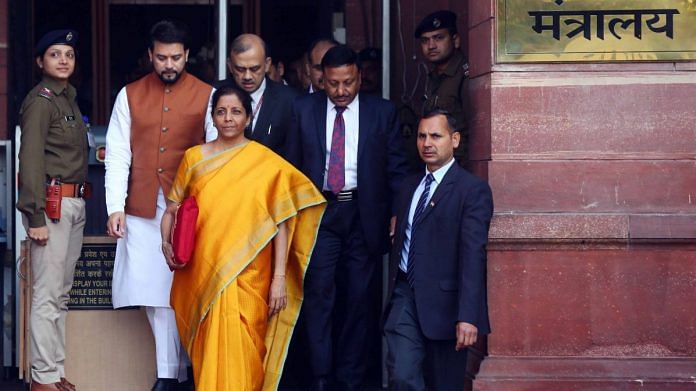Front Page
The jury is out on Finance Minister Nirmala Sitharaman’s record-breaking two-and-a-half-hour-long Budget speech Saturday — all the newspapers mention its length.
The Indian Express writes that the “NDA-2 government decided to play safe…”. Most of the mainstream newspapers echo that by emphasising the positive takeaways. Some fine illustrations lighten what is otherwise a heavy subject.
In their headlines, Express and The Hindu appear disappointed, while The Times of India and Hindustan Times use tax benefits as the positive peg.
The pink papers are equally ambivalent: “Long Wobbly Flight to Recovery”, writes The Economic Times, adding that there are only “few winners in FM Sitharaman’s marathon speech”. Business Standard is more optimistic: “Budget takes a leap of faith”, it says, adding that Sitharaman “sought to restore confidence in the budgetary process by restructuring the fiscal consolidation path while staying within the confines of the Fiscal Responsibility and Budget Management Act”.
The Telegraph, as usual, is bold and brutal: “Blank Bullets, Diabolic Bullets” linking the Budget’s lack of “vision and firepower to ignite a faltering economy”, with Saturday’s shooting at Shaheen Bagh. It adds ominously, “They want us to get used to both”.
Express features a quarter-page illustration of the finance minister with the headline, “In slowdown, Budget slows down on growth”. It also features five reports on the government’s “safe play”, income tax slab cuts, disinvestment goals, falling markets during Budget speech, and on the high-salaried people who will be hit by income tax. “Facing one of the steepest slides in growth… The NDA-2 government decided to play it safe when it came to imparting a positive impulse to the economy,” the paper writes.
For a change, the straight-faced Hindu gets playful: “Booster Short” reads its headline. The report highlights the key takeaways for different sectors, including industry, infrastructure, taxation, and the social sector.
Making a strong opening comment on the speech, the report says it “sought to make up in length and breadth for what it couldn’t deliver in the form of an effective stimulus for India’s fast-slowing economy.” An illustration by Deepak Harichandan breathes life into the front page, which also features various reactions to the Budget from members of the opposition as well as senior BJP leaders.
Hindustan Times, in “Micro Gamble for Macro Gain”, details how this Budget “comes against the backdrop of the slowest rate of growth in 10 years”, and highlights that the “Union Budget….offered an estimated Rs 40,000 crore of tax concessions…”. The flap features a detailed account of how the income tax slabs have changed and who will be affected how much, along with a section on how the “Markets crashed as Budget unveiled”.
TOI also concentrates on the tax benefits: It asks, “Are you richer or poorer?”, detailing the new income tax slabs. However, the flap features a report on how the “Southern states biggest losers in new tax sharing formula”.
The front page illustration “Nirmalathon” breaks down the Budget into eight obstacles, while “New Tax Deal For The Common Man” recalls cartoonist R.K. Laxman’s beloved character and details how “in a marathon Budget speech, Nirmala Sitharaman offers the option of lower I-T rates but without exemptions, promises to enshrine a charter of rights for taxpayers, and seeks to make tax administration more transparent”.
Opinion
Hindustan Times: Sitharaman’s Budget numbers seem “honest”, says HT. Her admission that nominal growth in 2020-21 would be 10 per cent “is a clear admission that there are headwinds to growth”. HT argues that the “Budget’s promise is not what will be termed a ‘dream’ or a ‘big bang’.” It welcomes the FM’s proposal of “tax cuts for people earning less than Rs 15 lakh”. However, it can’t be said for certain “that an economic revival will automatically create jobs”. The verdict — “…not a bad report card for a budget presented in an inconducive macroeconomic environment with little fiscal headroom”.
Times of India: Almost echoing HT, TOI states that the “Budget is unlikely to catalyse a revival, but it’s safe”. The government “has sensibly taken an interim step to move personal income tax towards a simpler framework of lower rates”. However, though the Budget “offers a platform to showcase multi-sector reform proposals”, TOI says this was an opportunity “wasted”. The ideas can’t be “termed potentially game changing”. The newspaper concludes, “… the subtext of the Budget conveys the impression that the government believes economic challenges are cyclical and not structural”. It is “no surprise”, then, that the BSE Sensex plunged by a thousand points.
Hindu: In sharp contrast to HT and TOI, The Hindu is more critical. The Budget “is not a spend-and-stimulate exercise despite the fact that it has overrun the 3.3 per cent target on fiscal deficit by as much as 0.5 percentage points”. It is also not a “feel-good Budget” despite accounting for the new tax regime. The Budget “has been built on the assumption of a nominal GDP growth rate of 10 per cent” which is “optimistic given the state of the economy now”. It says “there is nothing spectacular about this Budget” and “…whether it flies or falls flat depends on how growth pans out in the economy”.
Indian Express: Express is also disappointed; it says the Budget must be seen in the context of “the limited financial resources as well as state capacity for undertaking any major public expenditure push to offset subdued private consumption and investment demand”, and to that extent, it is an “admission of this reality”. However, some proposals range from “introducing unnecessary complexity to outright bad”. For instance, if the government wanted to “stimulate consumption through tax cuts”, it should have been in a “straightforward manner”. Moreover, “the real negatives” were “raising customs duty” and taking no “action on subsidy rationalisation”. Express feels that the Modi government has “sadly… squandered this opportunity yet again”.



